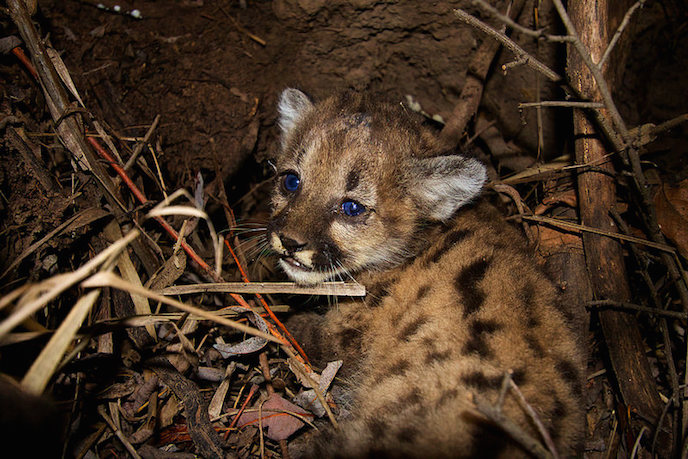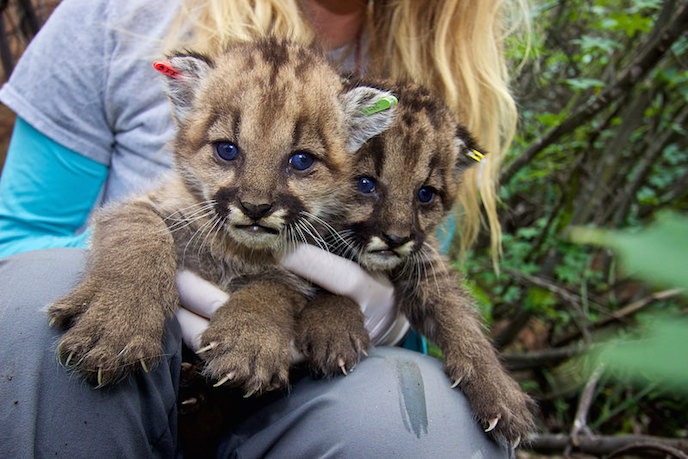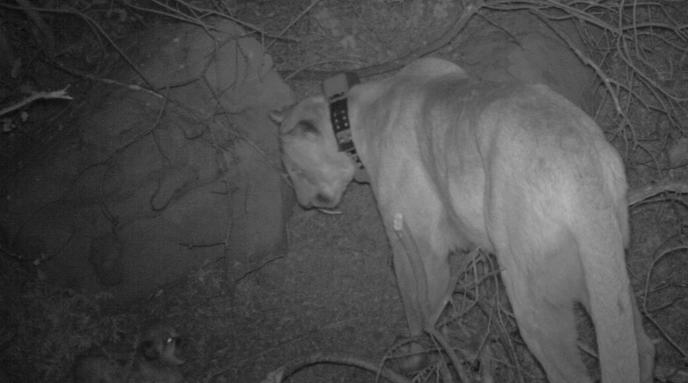 P-43 in July 2015. | Photo: National Park Service
P-43 in July 2015. | Photo: National Park Service
Today’s news about the recent mountain lion deaths includes a case of what appears to be a mountain lion killing young kittens. We’ve documented this happening at least one other time during our study and it’s also been documented in at least one other study.
So why would a mountain lion prey upon young kittens?
Let’s start with the first case, since we have some DNA test results to help us understand what happened.
P-36 and P-37, the adorable kittens in the photo below, were ear-tagged by biologist Jeff Sikich on February 27, 2015. They were P-23’s first litter.
 Kittens P-36 and P-37 in February 2015. | Photo: National Park Service
Kittens P-36 and P-37 in February 2015. | Photo: National Park Service
Sikich set up a remote camera to monitor the den and when he returned a few days later, he only found the remains of P-36 and P-37. He checked the remote camera images and found he had hundreds of images of a collared male entering the den and eating the kittens. Based on GPS data, he confirmed that the collared male was P-27.

DNA results from the Robert Wayne Lab at UCLA indicate the father of the kittens was P-12, the other dominant male in the Santa Monica Mountains. Could this have played a role in the predation? Researchers still aren’t sure.
“Although we still don’t know why P-27 killed P-36 and P-37, it could be considered advantageous for him to put the female back in estrus for breeding,” said Jeff Sikich, biologist for Santa Monica Mountains National Recreation Area. “She did end up mating again shortly after the death of her first litter, although we’re not sure yet who the father is of the most recent litter, which will be extremely interesting to learn.”
Based on GPS data, it appears that P-27 displaced P-23 from the kitten den (she left the area about the time he arrived) and then attacked the young kittens. After leaving the den, he seemed to follow P-23’s scent to where she had cached a deer kill, and then took over her kill.
P-27 left “scrapes,” or territorial markings, near the kitten den.
NPS biologists are awaiting the DNA results to determine not only the father of P-43 and her sibling, but also hopefully to determine the animal that killed them. He was able to swab some of the bite marks left behind at the scene.
No scrapes were left behind when P-43 and her sibling were killed, but Sikich did find fresh mountain lion tracks nearby. None of the mountain lions we are currently following seemed to be in the area at that time.
Many questions remain. Who killed P-43 and her sibling? Who was their father? Does the constricted space of the Santa Monica Mountains play a role in this predation in that P-23 seems to be struggling to avoid conflict with other animals?
Hopefully the DNA evidence will provide some clues.
![]()
